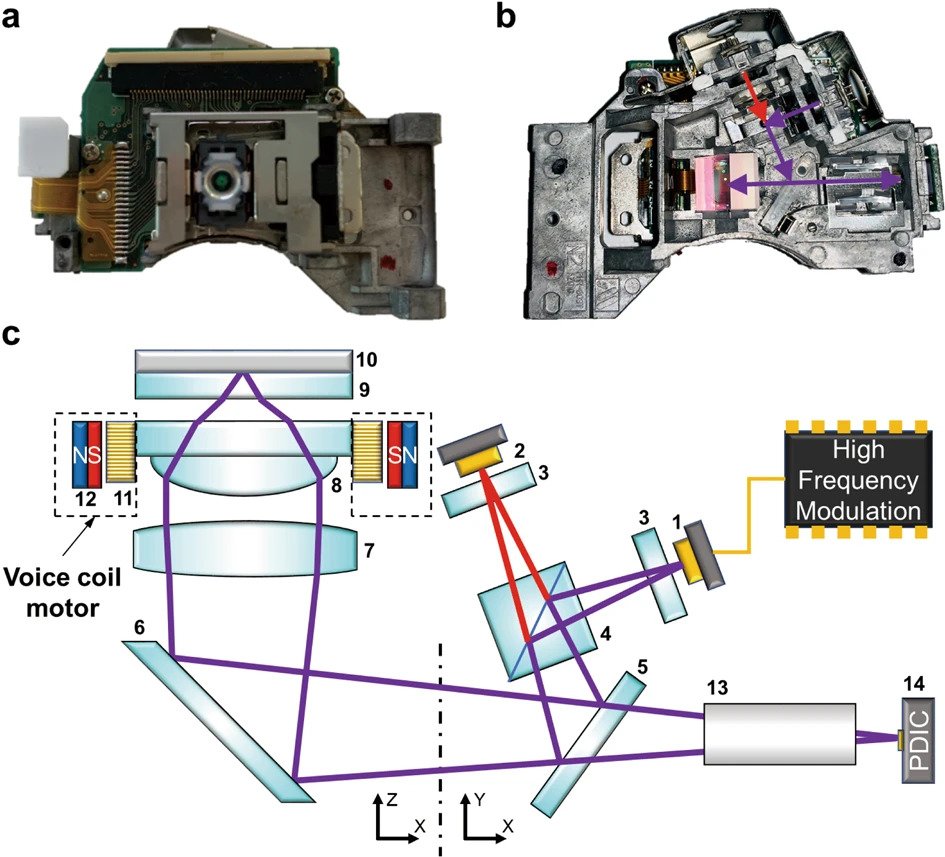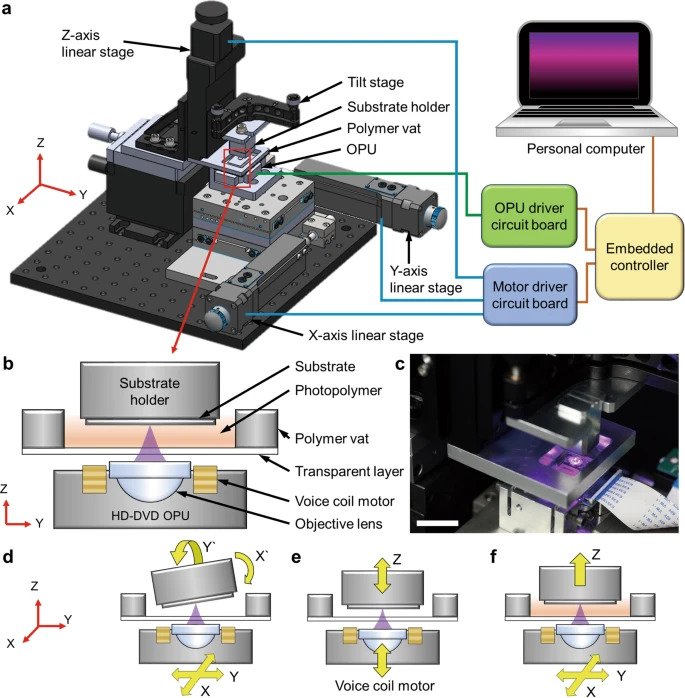Researchers from the Technical University of Denmark (DTU) have repurposed a component from a Microsoft Xbox 360 to develop a high-resolution large-volume nanoscale 3D printer with various applications in the medical sector.
The team took an optical pick-up unit (OPU) component from an Xbox 360 console to replace a conventional Stereolithography (SLA) optical system, in order to drastically simplify the SLA 3D printing system. With the OPU costing less than $5, the researcher’s solution could potentially increase the affordability of such equipment by thousands of pounds.
“With our 3D printer that can print micro and nanoscale 3D objects, we are able to go from tens of micrometers in printing resolution down to hundreds of nanometers without expensive specialized components,” said DTU PhD Student Tien-Jen Chang and research team member.
“And we also end up with a simpler and more compact nanoscale 3D printer compared to other stereolithography systems.”
Hardware hacking for affordability and simplification
Hacking consumer electronics and repurposing components is an interesting route towards utilizing readily available technology to develop less costly research equipment more quickly. Through repurposing the Xbox OPU, the DTU team hope to lower the threshold for more researchers to access micro and nanoscale 3D printing.
Hardware hacking has been undertaken before in the medical 3D printing world, after anarchist biohacking network the Four Thieves Vinegar Collective developed a 3D printable kit for homebrewing medication which served as an accessible alternative to industrial chemical reactors. Called the Apothecary Microlab, the device is capable of synthesizing homemade medication for conditions such as HIV, opiate overdoses, and pharmaceutical abortions. The collective has also 3D printed affordable versions of the Epipen and various other medical devices.
Open-source 3D printing, championed by the likes of the RepRap project, which celebrated its tenth anniversary in 2018, is another way in which technologies, software, and processes can become accessible to all, and holds a similar ethos to that adopted by the DTU researchers in opening up the affordability of SLA 3D printing equipment to others.

Hacking the OPU
An OPU is a component that reads and writes data from optical storage discs such as Blu-rays, high-definition DVDs, and CDs. The Xbox OPU not only provides a light source but also diffraction-limited optics in a compact size, and given its high-precision measurements and multiple wavelength laser modes, the researchers decided it would be an ideal replacement for conventional SLA optical systems.
The team extracted the HD-DVD OPU from an Xbox 360 and designed their own 3D printer based on an inverted SLA system, directing the laser spot upwards. The OPU emits a 405 nanometer laser focused inside the photopolymer vat, while an embedded controller connects to a customized OPU driver and motor driver to adjust the laser intensity and wavelength. The motor driver controls the XY-axis and Z-axis linear stages with resolutions of 312.5 nm and 62.5 nm respectively, as the embedded controlled communicates with a computer to implement the printing process.
While conventional SLA systems require external sensors for printing, substrate leveling, and achieving high-precision printing, the DTU researchers’ proposed OPU 3D printing system directly uses the embedded sensors to determine the distance between the focal spot and substrate surface at nanoscale resolution. The sensors can also adjust the substrate surface, OPU focal plane, and tilt stage, while a voice coil motor adjusts the objective lens to measure photopolymer thickness.
As a result of these alterations, the DTU team believe their OPU embedded sensing system could be used to significantly optimize and increase the yield of micro and nanoscale 3D printing.
“We believe that this technology can impact different areas of health technology,” said DTU Associate Professor En Te Hwu. “The original goal for developing our own 3D printer was to be able to print cubic centimeter volume with micro/nanoscale resolution for our own micro-container based drug delivery development. And we couldn’t find a 3D printer system on the market that could do this. So we had to make our own.”

Greater accessibility to medical 3D printing
As well as 3D printing their own microscale containers for oral drug delivery, the researchers foresee far wider applications for the developed technology across the medical sector. They also believe the OPU system has “great potential” for commercialization, and are planning on establishing a spin-out company based on this research within the next few years.
“In addition to 3D printing our microscale conatiners with a diameter of a human hair for more efficient oral drug delivery developments, this system can also be used to print painless microscale needles to be used on skin patches to speed up transdermal drug delivery developments,” continued Hwu.
Other potential applications of the technology could include printing 3D structures for cell culture environments for more accurate ex-vivo drug testing studies, and printing biocompatible micro-devices with nanostructured surfaces that kill bacteria.
“In the end, our goal is to help patients experience better diagnostics and treatment, for example through more accurate medical diagnostics, more efficient oral drugs, and better skin patches.”
Further information on the researchers’ technology can be found in the paper titled “Micro and nanoscale 3D printing using optical pickup unit from a gaming console”, published in the Communications Physics journal. The study is co-authored by T. Chang, L. Vaut, M. Voss, O. Ilchenko, L. Nielson, A. Boisen, and E. Hwu.
Subscribe to the 3D Printing Industry newsletter for the latest news in additive manufacturing. You can also stay connected by following us on Twitter and liking us on Facebook.
Looking for a career in additive manufacturing? Visit 3D Printing Jobs for a selection of roles in the industry.
Featured image shows Xbox 360 optical pick up unit (upper part) shining a blue laser on a substrate for micro/nanoscale 3D printing (lower part). Photo by Jesper Scheel/DTU.

Be the first to comment